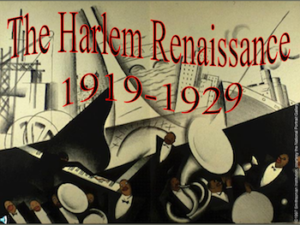
*On this date in 1924, we celebrate the dawn of the Harlem Renaissance.
On March 21st, 1924, Charles Spurgeon Johnson held a meeting at the New York Civic Club. The dinner brought together Black writers, pundits, white writers, and publishers. This event became a dress rehearsal for what would become the Harlem Renaissance.
Johnson’s dinner was a wonderful success, held at a critical time. Black philosopher and literary scholar Alain LeRoy Locke was invited to edit an issue of Survey Graphics, a social analysis and critique magazine. Also, in March of 1925, their special Harlem issue hit the newsstands with a blistering set of essays and poems directed at defining a unique Black aesthetic and new radical political viewpoint. Later in 1925, Locke expanded the issue into a book, The New Negro that crystallized the artistic and intellectual movement already underway. In this influential book, Locke described the northward migration of Blacks as "something like a spiritual emancipation."
There were indications that a new and exciting body of work would emerge from African American artists and writers in Northern cities. Though technically beginning in 1918, the Harlem Renaissance is the name given to the period in Black America from the end of World War I and through the middle of the 1930s Depression. During this time, talented African American writers produced extensive literature in four prominent formats: poetry, fiction, drama, and essay.
From 1920 until about 1930, an exceptional outburst of creative activity among African Americans occurred in all fields of art. Beginning as a series of literary discussions in the lower Manhattan (Greenwich Village) and upper Manhattan (Harlem) sections of New York City, this African American cultural movement became known as "The New Negro Movement" and later as the Harlem Renaissance.
The Urban League (Opportunity) and the NAACP (The Crisis) in-house magazines employed renaissance writers on their editorial staff, published poetry and short stories by black writers, encouraged new work through literary prizes, and broadened the black audience for literature. More than a literary movement and a social revolt against racism, the Harlem Renaissance established and exalted the unique culture of African Americans and redefined African American expression.
The Civic Club dinner paid long-term dividends: Ten years after that dinner, more than sixteen black writers published more than fifty volumes of poetry and fiction. African Americans began to and were encouraged to celebrate their heritage and to become "The New Negro," a term coined in 1925 by Locke. The personal quest for freedom expressed by this New Negro in American Blacks was one of individual survival.
It was also in response to the “Jim Crow Laws,” which ruined the Reconstruction legislation after the American Civil War. Innovations flourished in music. Bessie Smith and Ma Rainey sang the blues and became leading recording artists of the time. Jelly Roll Morton and Louis Armstrong married the rural South's blues to the city's overheated pace and transformed jazz. Another factor contributing to the rise of the Harlem Renaissance was the Great Migration of African Americans to northern cities (such as New York City, Chicago, and Washington, D.C.) between 1919 and 1926.
Black urban migration, combined with trends in American society toward experimentation during the 1920s and the rise of sweeping Black intellectuals, including Locke, Jesse Fauset, Richard B. Moore, William Trotter, Nella Larson, Marcus Garvey, Marita Bonner, and W. E. B. Du Bois contributed to Black artists' particular styles and unprecedented success during the Harlem Renaissance period.
Black America, A Photographic Journey: Past to Present,
Marcia A. Smith,
ISBN 1-57145-872-7, 2002
Thunder Bay Press, San Diego, CA
The African American Desk Reference
Schomburg Center for Research in Black Culture
Copyright 1999 The Stonesong Press Inc. and
The New York Public Library, John Wiley & Sons, Inc. Pub.
ISBN 0-471-23924-0
"TWO-GUN MAN FROM HARLEM"
Herbert Jeffrey, Mantan Moreland, Spencer Williams